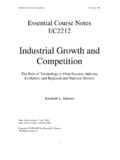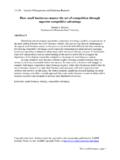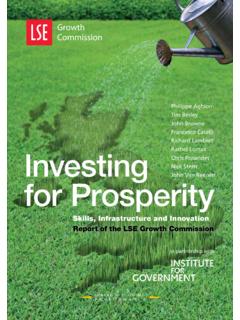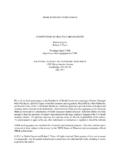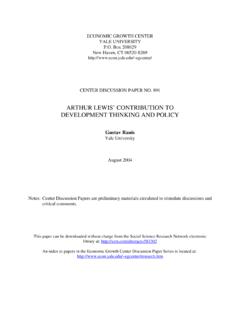Transcription of COMPETITION ASSESSMENT TOOLKIT - OECD.org
1 COMPETITIONASSESSMENT TOOLKIT1 principlesPRINCIPLES1 COMPETITION ASSESSMENT TOOLKITCOMPETITION ASSESSMENT CHECKLISTC ompetition ASSESSMENT should be conducted if a legal provision has any of the following effects:Limits the ability of suppliers to competeThis is likely to be the case if the provision:Limits sellers ability to set prices for goods or servicesLimits freedom of suppliers to advertise or market their goods or servicesSets standards for product quality that provide an advantage to some suppliers over others, or are above the level that some well-informed customers would chooseSignificantly raises costs of production for some suppliers relative to others (especially by treating incumbents differently from new entrants)Limits the number or range of suppliersThis is likely to be the case if the provision.
2 Grants exclusive rights for a supplier to provide goods or services Establishes a license, permit or authorisation process as a requirement of operationLimits the ability of some suppliers to provide a good or service Significantly raises cost of entry or exit by a supplierCreates a geographical barrier for companies to supply goods, services or labour, or invest capitalReduces the incentive of suppliers to competeThis may be the case if the provision:Creates a self-regulatory or co-regulatory regimeRequires or encourages information on supplier outputs, prices, sales or costs to be publishedExempts the activity of a particular industry, or group of suppliers, from the operation of general COMPETITION lawLimits the choices and information available to customersThis may be the case if the provision.
3 Limits the ability of consumers to decide from whom they purchaseReduces mobility of customers between suppliers of goods or services by increasing the explicit or implicit costs of changing suppliersFundamentally changes information required by buyers to shop effectivelyABCDA1A2A3A4B3B2B1B4A5C1C2C3D 1D2D3 COMPETITION ASSESSMENT TOOLKIT Volume 1 Principles Please cite this publication as: OECD (2017), COMPETITION ASSESSMENT TOOLKIT : Volume 1. Principles, Version This work is published under the responsibility of the Secretary-General of the OECD. The opinions expressed and arguments employed herein do not necessarily reflect the official views of the OECD or of the governments of its member countries or those of the European Union.
4 This document and any map included herein are without prejudice to the status or sovereignty over any territory, to the delimitation of international frontiers and boundaries and to the name of any territory, city, or area. OECD 2017 COMPETITION ASSESSMENT TOOLKIT , VERSION OECD 2017 3 Foreword Increased COMPETITION improves a country s economic performance, opens business opportunities for its citizens and reduces the cost of goods and services throughout the economy. However, numerous laws and regulations may unduly restrict COMPETITION in the marketplace.
5 Governments can reduce unnecessary restrictions by applying the methods described in the OECD s COMPETITION ASSESSMENT TOOLKIT . The TOOLKIT provides a general methodology for identifying unnecessary restraints and developing alternative, less restrictive policies that still achieve government objectives. A key element of the TOOLKIT is the COMPETITION Checklist that asks a series of simple questions to screen for laws and regulations that could unnecessarily restrain COMPETITION . This screening focuses limited government resources on areas where COMPETITION ASSESSMENT is most needed.
6 Governments can use the TOOLKIT in three ways: To evaluate draft new laws and regulations (for example, through regulatory impact ASSESSMENT programmes) To evaluate existing laws and regulations (either in the economy as a whole, or specific sectors) To evaluate the competitive impacts of regulation (either by the government bodies that develop and review policies -or the COMPETITION authority. It is designed for use in a decentralised fashion across government, at both national and sub-national levels. The TOOLKIT materials were designed with this flexibility because restrictions on COMPETITION can be implemented at different levels of government, and COMPETITION ASSESSMENT is useful at all levels.)
7 One of the most successful examples of pro-competitive reform occurred in a federal system when Australia implemented broad, pro-competitive reforms at both national and state level in the mid-1990s. Since that time, Australia has experienced strong economic performance, with high and steady growth that has raised Australia s economy from a mid-level FOREWORD 4 COMPETITION ASSESSMENT TOOLKIT , VERSION OECD 2017 performer to one of the top performing OECD economies. In a 2013 large COMPETITION ASSESSMENT project, economic benefits from implementing recommended changes amounted to around EUR billion (OECD, 2014a).
8 In another project, benefits were estimated at around or more of GDP (Sims, R., 2013 and Productivity Commission, 2005). While not all projects will have such large impacts, benefits from COMPETITION ASSESSMENT can often be substantial. The TOOLKIT can be used by officials without specialised economic or COMPETITION policy training. Potential users include: ministries, legislatures, government leaders offices, state governments and external policy evaluators. The COMPETITION ASSESSMENT TOOLKIT is available in many languages to encourage its broad use and adoption.
9 It contains three volumes: Volume 1 - COMPETITION ASSESSMENT Principles - gives examples of the benefits of COMPETITION , provides an introduction to the COMPETITION Checklist and shows ways that governments assess the competitive effects of their policies; Volume 2 - COMPETITION ASSESSMENT Guidance - provides detailed technical guidance on key issues to consider when performing COMPETITION ASSESSMENT ; and, Volume 3 - Operational Manual for COMPETITION ASSESSMENT - is a step-by-step guide for performing COMPETITION ASSESSMENT .
10 All related materials can be found on the OECD s website at Acknowledgements The COMPETITION ASSESSMENT TOOLKIT was developed by Working Party No. 2 of the COMPETITION Committee, with the input of many OECD delegations, both from Member and non-Member economies, and other OECD bodies with an interest in these areas, including the Regulatory Policy Committee and the Consumer Policy Committee. At the OECD Secretariat, the materials were drafted by Rex Deighton-Smith, Sean F. Ennis, Vivek Ghosal, Marta Troya-Martinez, Mark Ronayne, Cristiana Vitale and Sabine Zigelski, under the leadership of Sean F.










